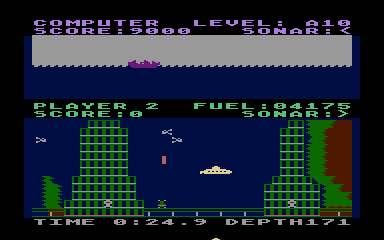Nautilus (video game)
| Nautilus | |
|---|---|
| Developer(s) | Mike Potter |
| Publisher(s) | Synapse Software |
| Designer(s) | Mike Potter |
| Platform(s) | Atari 8-bit |
| Release date(s) | 1982 |
| Genre(s) | action |
| Mode(s) | single or two player |
| Distribution | floppy disk, cartridge |
Nautilus is a 1982 computer game for the Atari 8-bit series created by Mike Potter and distributed by Synapse Software. The players control a submarine, the Nautilus, or a destroyer, the Colossus, attempting to either destroy or rebuild an underwater city. The game is historically notable as the first to feature a "split screen" display to allow both players to move at the same time.[1]
Gameplay

Nautilus started with player one in control of the submarine, visible in the lower pane of the split-screen display. The joystick allows the user to move left and right or rise and sink - the submarine was always pointed to the left or right. The player can shoot torpedoes to the right or left in the direction of travel. The primary task for the player is to move into location beside the various underwater buildings and destroy them with their torpedoes in order to expose their energy core, which can be picked up by moving over it. The player wins the level by collecting all of the cores. To help defend the submarine, a helicopter periodically flies by in the higher levels, attacking the destroyer.
Player two, or the computer player in a single-player game, controls the destroyer, visible in the upper pane. The ship's primary task is to ferry repair crews from the right side of the map back to the left, dropping them into an elevator that takes them to the bottom of the ocean. From there they quickly move back towards the right through a tube on the ocean floor, instantly repairing the buildings directly above them as they pass. The destroyer also drops depth charges and missiles that attack the submarine, as well as leaving limpet mines on the sea bed. These are relatively easy to dodge in most cases, and the most dangerous enemy is often the construction crews, who may fix one of the buildings while the Nautilus is inside, retrieving the core.
In two-player mode the actions of the destroyer are relatively limited. The delay between dropping charges and them reaching the submarine is enough to allow the sub to destroy an average building before they arrive, so the ship cannot easily directly attack the sub in order to prevent it from winning. This forces it to act as a ferry for the repair crews, hardly the most exciting game, even when punctuated by the periodic helicopter attacks.[2]
Technical details
Nautilus is an excellent example of the sorts of graphical "tricks" the Atari 8-bit series was capable of. Graphics were drawn by a pair of co-operating display chips, the ANTIC which was in charge of the background graphics and text, and the GTIA which handled player-missile graphics in the foreground and was in charge of adding color. The ANTIC was instructed how to set up the screen on a line-by-line basis by instructions encoded in the "display list", which included flags for options like smooth scrolling. This allowed the display to support different options or modes vertically down the screen.
In the case of Nautilus, the display list was set to divide the screen into five sections. At the top was a low-resolution text area displaying the score, followed by the horizontal-scrolling map used by the Colossus, followed by another text score area, a 2-D scrolling area for the Nautilus, and finally another text area for the status at the bottom. The graphics for each of these areas would be held in a separate area in memory. The ANTIC had a single register holding the position of the smooth scrolling. In order to have different scrolling positions for the upper and lower portions of the screen, the ANTIC was instructed to cause an interrupt after the second text area, calling into the 6502 to set the scrolling register to a different position.
Reception
Nautilus was widely lauded at the time of its release,[2][3] with Creative Computing calling it a "tour de force".[4] In an article about Synapse, an InfoWorld author noted no one was examining their highly rated relational database program, in favour of watching a game of Nautilus being played.[5]
References
- ↑ "Mike Potter's Story", The Giant List of Classic Game Programmers, 17 January 2000
- ↑ 2.0 2.1 "NAUTILUS", ANTIC, October 1982, pg. 50
- ↑ "Nautilus", Computer Gaming World, 1983, pg. 39
- ↑ "Nautilus", The Creative Atari, 1983
- ↑ "Synapse Software helps bridge the gap in programs for Atari", InfoWorld, 26 July 1982, pp. 25-26